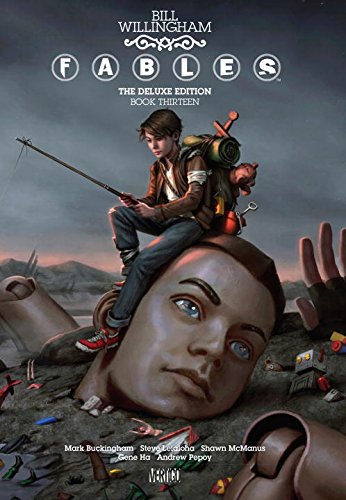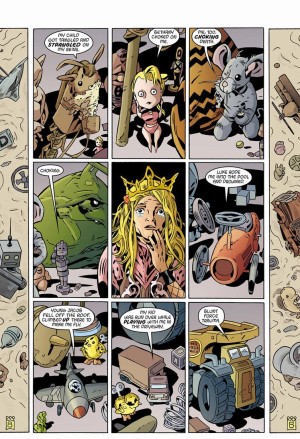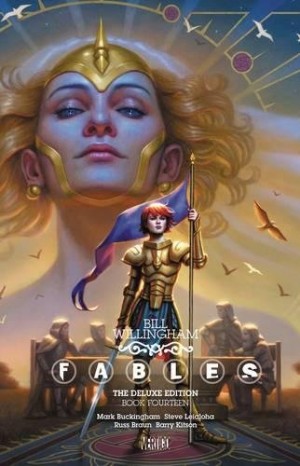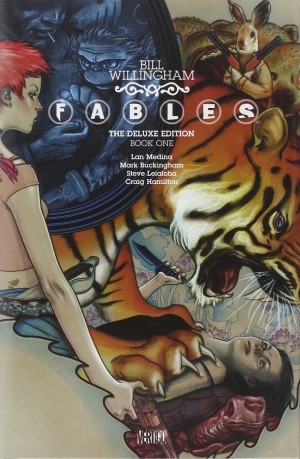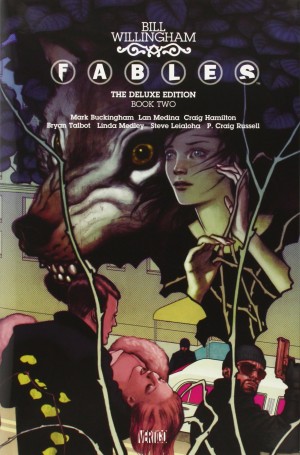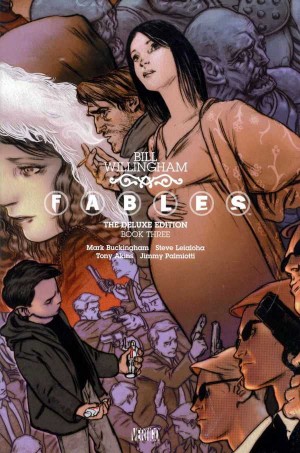Review by Frank Plowright
With the previous book the spotlight turned in the direction of Bigby Wolf and Snow White’s children, who’re increasingly pertinent to the remainder of Fables. One was told a prophecy about his brothers and sisters, and the fates of some are clarified in what’s the bleakest sequence of the entire Fables run, collected in paperback as Cubs in Toyland.
The Toyland that features isn’t the magical place of joy and play still vaguely familiar from fondly recalled childhood stories, but the land where the discarded and unwanted toys relocate to fester in resentment. When Therese and then Darien visit they learn some unpalatable truths in what’s a character transforming sequence. It’s a story that flies in the face of any (unfounded) accusations that Fables can wallow in sentimentality and has a memorable haunting quality despite a fundamental plot flaw underpinning matters. Are toys really turned evil due to participation in events beyond their control?
Writer Bill Willingham offers a meditation on fate in the following, shorter piece, and pay attention as although it may seem a sidetrack, elements of it have a later significance.
As is pretty well always the case, Mark Buckingham is near faultless throughout. He and colourist Lee Loughridge adapt the usually cheerful style for the gloom and the depression of the opening sequence, and he’s back in familiar territory for what was collected in paperback as Snow White. Although he’s been seen lurking beforehand, the final of the major Fables villains is now revealed in full as Prince Brandish, expert swordsman, cold of heart and considering himself still married to Snow White. Needless to say, that’s not a stance that goes down well with Snow White, and it’s just as well Bigby is occupied elsewhere. She’s not the only one with problems, as the Blue Fairy has also arrived in Fabletown to claim her due.
The guest artists featured contribute longer sequences. The always elegant Gene Ha works on ‘The Destiny Game’ and ‘A Revolution in Oz’ is the work of Shawn McManus. This is in shorter, frothier sequences, and a deliberate contrast to the glum material that preceded it. Bufkin appeared to have met a grim fate after instigating said revolution, but Willingham is nothing if not a man well equipped to navigate tight narrative corners, and there was definite wiggle room. The revolution continues. What worked well enough as three page segments in individual comics has a wacky repetitive quality when collected together, and although not without charm, it’s a very tolerant reader who’ll laugh all the way to the sentimental conclusion.
That, though, is an interlude, and the remainder of the Snow White sequence features enough tension, intrigue and surprises to keep us all happy. It culminates with an anticipated showdown, brilliantly delivered by Willingham and Buckingham.
The relative cost of these hardback editions may be offputting, particularly with a series due to run to fifteen volumes in total, but they’re gathering a landmark series that very rarely dips in form. A prospective new reader is advised to try a cheap second hand copy of any Fables paperback other than The Great Fables Crossover before deciding to invest in these hardbacks. This is also available spread over Fables Compendium Three and Four.
